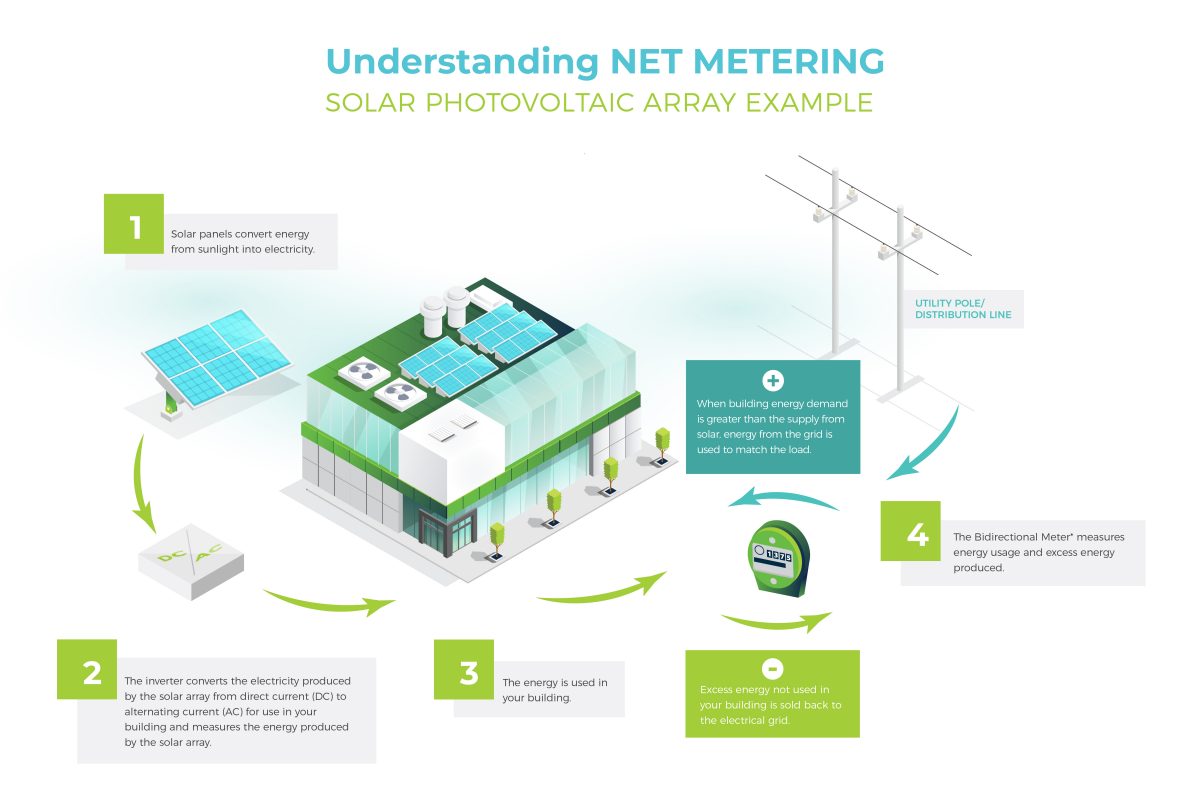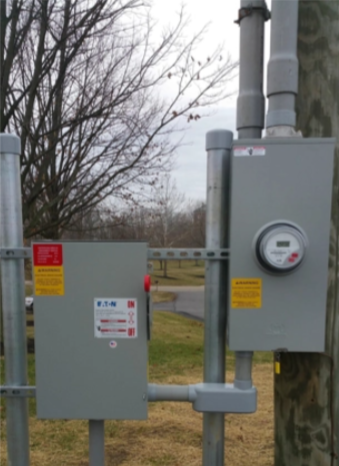Net Metering Program Types
Considering sourcing your building’s power from the sun? An important concept to understand is net metering and whether it’s available in your state.
Net metering is a billing incentive that offers credits to solar customers when their solar energy systems produce more electricity than consumed. Excess power generated through solar feeds back into the utility grid, thus qualifying the owner for a “credit” on his or her electric bill. Likewise, “debits” will show up as a charge on the electric bill if more energy is used from the grid (above and beyond the solar energy produced during the billing period).

How Does Net Metering Work?
Power produced by solar = Credits, Electricity consumed from the grid = Debits

The net of these two is how net metering functions, factoring in whether you’re charged for grid usage or owed down the road for solar production. Is it common for net energy metering (NEM) customers to produce than they consume? There’s a fair amount of predictability in the variation of energy production over a year. That’s why net metering is particularly helpful, accounting for seasonality. It allows owners to bank credits during summer months when systems produce more due increased sun exposure, then use those credits during winter months when systems generate less due to shorter days.
There are daily variations in energy production and usage as well. Solar energy systems will usually hit peak production in the afternoon during the time of highest sun exposure. Net metering ensures the owner is credited for these natural swings in production and helps balance solar electricity throughout the year.
How much power from solar usually ends up feeding back into the grid? Solar Energy Industries Association’s Net Metering Facts references a Crossborder Energy analysis that shows, on average, “less than half of a solar energy system’s output goes into the grid, and any excess solar electricity serves nearby customers’ loads.” Very few customers with solar fully offset all of their power usage every month. The majority will still have to pay a portion of their utility bills. However, over a solar energy system’s lifespan, net metering allows owners to bank years’ worth of savings by reducing the amount purchased from the grid.

Net Metering Policies
It’s important to fully understand your state’s policies regarding net metering compensation. EnergySage explains how net metering rules can vary. “If you do generate more electricity than you use in a year, utilities in some states will let you carry credits over into future years, while others will reduce your credits.” Do not confuse credits with cash payments, unless you live in a state that allows for that type of compensation. While you can stock up on credits to cover power you may need from the grid throughout the month or year, don’t assume the utility companies will be sending a check covering the retail rate.
Additionally, while net metering is authorized in most states, there are different approaches to how they distribute credits, assign eligible technology, and handle capacity limits. The National Conference of State Legislatures expands on state specific laws in their Net Metering Policies article. Again, one cannot make assumptions about compensation without digging into state rules. For example, “California credits excess generation to a customer’s next bill at retail rate. After a 12-month period, customers can choose whether to roll credits over indefinitely or receive a payment for credits at the wholesale rate. If no option is selected, credits are granted to the utility with no customer compensation.” In this case, the owner can opt in for credits at the end of the year, but it will be at the wholesale rate.
Net metering policies were originally intended for areas with lower solar adoption. As more and more states become reliant on clean energy, we can expect policy changes to occur. Regardless of your state’s current policy, it’s important to understand how different factors can affect your long-term savings from solar panel systems.
Net Metering Examples
Essentially, net metering combines the solar kWh sent to the grid (or produced) with the kWh taken from the grid (used) and shows you the “net.” This is called “Total Usage” by your utility provider on your electric bill.
Example 1
Your solar array produced 200 kWh in a given month, which was sent to the grid. Your monthly consumption was 300 kWh. Your Total Usage (net usage) on your electric bill would read as 100 kWh.
Example 2
Net meters can also show a negative if you sent the grid more kWh than you used. Let’s say you sent 300 kWh of solar to the grid in a given month. You used 200 kWh in consumption. Your Total Usage (net usage) is -100.

Net Metering Program Types
There are several types of net metering programs available, and they vary by utility provider.
Monthly Net Metering with Wholesale Surplus Generation Credit
Energy exported into the grid is credited at the retail energy rate up until the point where all energy costs have been offset for the month. If there is a net energy export for the month, the net energy exported will be paid at the wholesale energy rate. If there is no net energy export for the month, no credits will be given.
Annual Net Metering with Wholesale Surplus Generation Credit
Energy exported into the grid is credited at the retail energy rate up until the point where all energy costs have been offset for the year. If there is a net energy export for the year, the net energy exported will be paid at the wholesale energy rate. If there is no net energy export for the year, no credits will be given.
Monthly Net Metering with Non-Bypassable Charges & Wholesale Surplus Generation Credit
Energy exported into the grid is credited at the retail energy rate minus any user-specified Non-Bypassable Charges up until the point where all energy costs have been offset for the month. If there is a net energy export for the month, the net energy exported will be paid at the wholesale energy rate. If there is no net energy export for the month, no credits will be given.
Annual Net Metering with Non-Bypassable Charges & Wholesale Surplus Generation Credit
Energy exported into the grid is credited at the retail energy rate minus any user specified Non-Bypassable Charges up until the point where all energy costs have been offset for the year. If there is a net energy export for the year, the net energy exported will be paid at the wholesale energy rate. If there is no net energy export for the year, no credits will be given.
No Net Metering with Fixed Ration for All Energy Exported
All energy exported into the grid is paid at the specified export rate.
Case Studies
No posts found.
